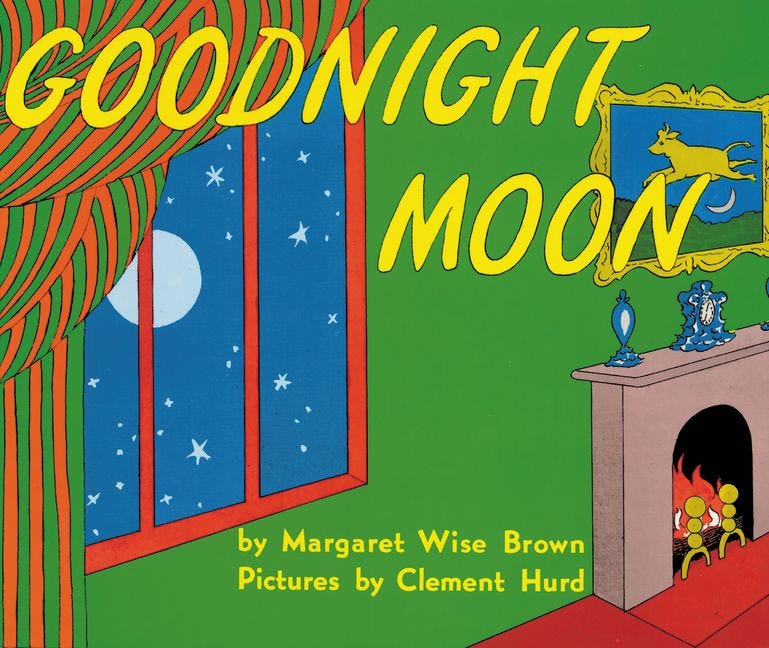Our sons are now 25 and 23 years old. It’s been a while since we’ve read either of them a bedtime story, but like most parents, Jen and I can still feel the tightrope walk between calm and chaos that of bedtime for young children. Emotional angst and exhaustion exist in barely discernible proximity to comforting quiet and calm. Parents can feel it in those bedtimes, but you don’t have to be a parent to know how disturbingly close those things can be to one another.
One of the books that most parents will remember, a book that is still widely read today is “Goodnight Moon” by Margaret Wise Brown. It is a simple, 131 word children’s book that tells no story, but rather consists of a series of observations and goodnight addresses. I think that one of the reasons Goodnight Moon is enduring is that it demonstrates the beauty of prayer, even for those who don’t consider themselves to be pray-ers. The book is not so much read, as breathed.
Goodnight room.
Goodnight moon.
Goodnight cow jumping over the moon.
Goodnight light, and the red balloon.
A recent column on the book that was published in 1947 refers to its “enduring wisdom”. Following links in that column brings interesting knowledge about Margaret Wise Brown. When Brown was writing kids’ books it was still somewhat counter-cultural. Children were perceived to be “incomplete adults”. There was not the understanding then that we have now of developmental stages. Brown wrote under other names, among them Golden McDonald and Juniper Sage. Her house in Maine had no indoor plumbing or heat or electricity or phone. She rented a house in Manhattan that she decorated in fur and used as a writing studio. Does that make her eccentric? Does such eccentricity make the book even more charming?
I think that the book reveals something about prayer because of its calm amidst the chaos. Much religious thinking and education has presented prayer as something that is a spiritual practice, taken up with devotion and discipline, something that “believers” do. Evangelical Christian culture often places prayer among the many injunctions of activity. “You should pray and you should read your Bible." In many evangelical circles this was called “quiet time”.
What if the start of understanding prayer is not to consider a practice imposed or taken up, but rather something that we already do?
Goodnight Moon resonates, in part because of its simplicity and because of its cadence. There are things observed, items inside and outside of the room are briefly noted. Next, they are granted attention, a kind of address - “Goodnight kittens and goodnight mittens. Goodnight clocks and goodnight socks.”
In articulation of Hopeful Christian theology I often quote Simone Weil, “Attention, taken to its highest degree is the same thing as prayer. It presupposes faith and love.”
This is the simplicity of Goodnight Moon. The cadence is the rhythm. In Christian spirituality (other religious faiths as well) there is something called “Breath Prayer”. It takes the often wordy, complicated practice of prayer and simplifies it to a few words that can be said in breathing in and breathing out. Cole Arthur Riley, Sarah Bessey and others have brought this ancient practice into contemporary expression. Breath prayer is cadence.
Christian Examples:
Inhale: “Lord Jesus Christ, son of God.”
Exhale: “Have mercy on me, a sinner.”
Inhale: “Humble and gentle One.”
Exhale: “You are rest for my soul.”
Do you not consider yourself a pray-er? You are most certainly a breathe-er. That is somehow where prayer begins. It is accepting the ever present invitation of entering that room of calm, even if angst and chaos are so close. Faith and prayer and hope are not imposed, they are recognized and fostered. You might try some Christian breath prayers if you are interested or you might just read Brown’s book again, even if you haven’t in years.




One of my favorite breath prayers is to breathe in Love and exhale Light...then breathe in Light and exhale Love.....thanks for another great column.....
Beautiful. Amen. Mary Ruth Wilkinson talked about this book in her books for children/youth class (I don't remember the name) and it is such a simply naming of what there is, that recognition that it is a part of our life that exudes gratefulness.
I love breath prayers. My favourite is "Yah - weh" especially when I'm undergoing some form of physical treatment or exercise - kind of like I'm inhaling the Holy Spirit and letting it replace some of the stress and worry, doubt and distress that I carry so close in my brain - it's like letting my heart have a hold of it and letting it go.
On my desk I have "SPEAK LORD, for your servant is listening." At one time the breath prayer, encouraged by Cassian, "Come to my help, O God; Lord, hurry to my rescue" was what was on my desk. It might be time for me to revert back to that. Simply recognizing that He was embodied, we are embodied and that life and living can be recognized as a part of the holiness of creation - Good night moon. Good night computer, good night lamp. Thank you for helping me to do God's work today. Thank you God for these simple (and complex) things that you have given to me to do your work today (even when most of the day I did things in my own power and for my own good).
Thank you for sharing. For helping to remind me that these gifts I'm surrounded by I ought to be grateful for and the simple perspective change of saying "good night" is a moment of graceful gratefulness.